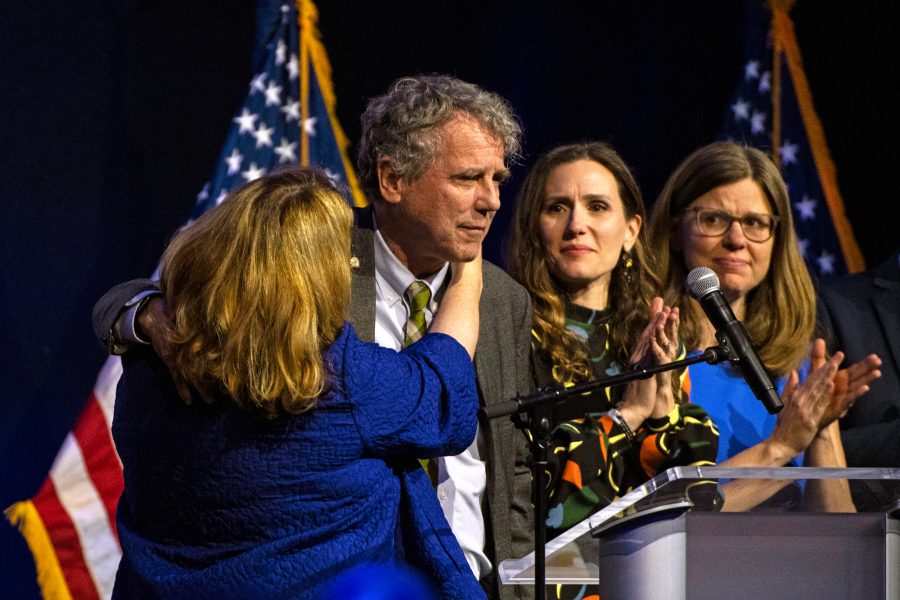As Global Hunger Levels Remain Stubbornly High, Advocates Call for More Money to Change the Way the World Produces Food
As much of the world heads into the fall harvest season and agriculture once again enters international policy conversations, humanitarian groups are calling for fundamental changes to the global food system—not only to feed the world’s hungry but also to enlist more farmers in solving the climate crisis.
At the United Nations annual climate conference, being held this November in Azerbaijan, a working “hub” organized by the UN’s Food and Agriculture Organization (FAO) and conference leaders will focus on agriculture and food systems. Agriculture will also get the spotlight at an upcoming UN conference on desertification and at Climate Week in New York, during the UN General Assembly next month.
This intensified attention on food systems, which generate between one quarter and one-third of global greenhouse gas emissions, adds to momentum building for the past couple of years as advocacy and policy groups have moved agriculture toward the forefront of climate policy discussions. In 2022 and 2023 at the UN’s annual climate conferences, referred to as COPs for conference of the parties, food systems and agriculture got increasingly higher billing.
Explore the latest news about what’s at stake for the climate during this election season.
“Food and agriculture is, indeed, a big part of the agenda again, heading into COP29. I think what we’ve seen in the past few years is a major change in that agriculture and food systems and food security are no longer confined to one small part of the conversation,” said Kaveh Zahedi, director of the office of climate change, biodiversity and environment at FAO. “It took about 20 COPs for food to be even mentioned at a COP. It was invisible.”
The attention, hunger and food advocacy groups say, can’t come soon enough: As agriculture’s role in the climate crisis has become more prominent, so have the inequities in the global food system, prompting more urgent calls for a major agricultural overhaul.
Within 25 years, the world’s farmers will have to produce 50 percent more food than they do now, and already one in 11 people on the planet doesn’t have enough to eat. As climate change continues to fuel more disruptive weather events, from drought to floods, the UN estimates that 1.8 billion more people could be pushed into hunger by mid-century.
For the past three years, the number of hungry people around the world has stayed at frustratingly high levels, foiling aid and humanitarian groups that celebrated a decline in hunger through the previous decade. In its annual flagship report on global hunger published in July, FAO and the other major UN food agencies said that roughly 773 million people on the planet are facing acute hunger.
“We saw a big jump during COVID, but the numbers aren’t going down,” Zahedi said. “There are, of course, regional differences, but the number I find quite shocking—in Africa, one in five people face hunger.” In South America, where countries spend more on social programs, the numbers are heading in a positive direction, with 5 million fewer people going hungry on that continent in 2023 over the previous year, the FAO report found.
Wars, conflict and economic conditions are primary drivers of hunger. In Sudan, an ongoing civil war has pushed millions of people to the brink of starvation, as opposing sides have choked off supplies and weaponized the lack of food against their own people. The ongoing war in the Ukraine, a major wheat grower, has roiled global grain markets, raising prices. The Israel-Hamas war drove nearly 580,000 people into famine, the most severe level of food insecurity and the most severe crisis since the UN assessments began. By the latter part of 2023, the entire 2.2 million population of Gaza was facing crisis-level hunger, the FAO report said.
But climate change is, increasingly, becoming the primary driver in many parts of the world.
“We have 18 countries where 71.9 million people face high-acute food insecurity because of weather extremes,” said Gernot Laganda, who leads climate and disaster risk reduction programs at the UN’s World Food Program (WFP). “So a larger number of countries with a larger number of people.”
Most of these countries were in Africa and Latin America. In 2020, that number was 15.7 million in 15 countries, mostly in Africa, Latin American and South Asia.
The WFP, the world’s largest humanitarian aid organization, has only 50 percent of the funding it needs to reach the world’s hungriest people. It provides the bulk of the food aid distributed by relief agencies but is chronically stretched, bouncing from crisis to crisis. Laganda and others have called for years for the UN food agencies to change the way they respond to hunger by providing financing to potential victims ahead of a crisis.
“We didn’t see the Russian invasion or COVID coming,” Laganda said. But with improved technology for better predictive forecasting, experts can position resources in potential crisis areas before they happen, he explained. “We need to invest in these capabilities for countries that are getting hit the hardest. That’s not happening at the scale and speed that’s required.”
Laganda said that of all the funding in the international aid system, only 2 percent is in place ahead of time. The rest is raised and distributed on the fly.
“We’re not moving from a system that’s waiting for things to happen and then using very costly resources to absorb the shocks—we’re not moving from that age-old model into a model that pre-positions financing and makes that financing available before these shocks happen, which would gives us the time, and the communities [time], to brace for impact,” Laganda said.
The July FAO report not only notes the stubbornly high number of acutely food insecure people across the world, but also emphasizes a need for better global financing to help lower- and middle-income countries adapt to weather extremes driven by climate change. In June, the Rome-based UN food agencies—WFP, FAO and the International Fund for Agricultural Development (IFAD)—met with COP organizers to plan for the Azerbaijan conference and called for an urgent scaling up in climate action and financing to help farmers, especially in politically fragile counties.
“All three Rome-based agencies are working closely with the incoming [COP] presidency to take this forward,” said Juan Carlos Mendoza, who directs climate efforts at IFAD. “There’s going to be an increased focus on financing.”
More of the funding needs to go toward helping farmers make their operations more resilient to climate shocks, by, for example, planting crops better suited for the conditions, taking steps to develop their soils to withstand drought or flood conditions, or growing crops and raising livestock in ways that don’t lead them to cut down trees. Deforestation is the largest source, globally, of greenhouse gas emissions from agriculture.
“By managing landscapes in a more integrated manner and improving farming methods to make farms more regenerative, we can make food systems more resilient,” Laganda said.
While “regenerative agriculture” is a somewhat fuzzy concept, conversations about it will be prominent at Climate Week in New York next month.
“There’s a definition issue with regenerative agriculture, but we really define it in terms of outcomes,” said Roy Steiner, who leads food initiatives at the Rockefeller Foundation and will be a panelist at upcoming events during Climate Week. “Regenerative agriculture moves you toward better soil health, better biodiversity, better water quality and better farmer well-being. Ninety percent of agriculture in the world doesn’t meet that definition.”
The foundation’s research suggests that it will take $400 to 500 million over the next decade to transition more agricultural systems in that direction.
Roughly $600 million a year in government subsidies goes toward agriculture, 80 percent of which flows to larger agricultural operations that grow or produce major commodities and tend to be more greenhouse gas intensive. The World Bank has even called for those subsidies to be redirected toward lower greenhouse gas-emitting farms and food production.
“That 80 percent is not going to regenerative agriculture,” Steiner said.
This type of farming improves soils, making them better able to sequester planet-warming carbon dioxide, and produces livestock in less greenhouse-gas polluting ways. But it has benefits beyond greenhouse gas reductions.
“Globally we depend on just a handful of crops,” Laganda said. “The diversification of food systems is an important part of the conversation. Diversified farms are more resilient.”
Greater resilience, Laganda said, will mean the world’s small-scale farmers can weather climate extremes better and feed their communities when a crisis strikes.
About This Story
Perhaps you noticed: This story, like all the news we publish, is free to read. That’s because Inside Climate News is a 501c3 nonprofit organization. We do not charge a subscription fee, lock our news behind a paywall, or clutter our website with ads. We make our news on climate and the environment freely available to you and anyone who wants it.
That’s not all. We also share our news for free with scores of other media organizations around the country. Many of them can’t afford to do environmental journalism of their own. We’ve built bureaus from coast to coast to report local stories, collaborate with local newsrooms and co-publish articles so that this vital work is shared as widely as possible.
Two of us launched ICN in 2007. Six years later we earned a Pulitzer Prize for National Reporting, and now we run the oldest and largest dedicated climate newsroom in the nation. We tell the story in all its complexity. We hold polluters accountable. We expose environmental injustice. We debunk misinformation. We scrutinize solutions and inspire action.
Donations from readers like you fund every aspect of what we do. If you don’t already, will you support our ongoing work, our reporting on the biggest crisis facing our planet, and help us reach even more readers in more places?
Please take a moment to make a tax-deductible donation. Every one of them makes a difference.
Thank you,
David Sassoon
Founder and Publisher
Vernon Loeb
Executive Editor
Share this article
Disclaimer: The copyright of this article belongs to the original author. Reposting this article is solely for the purpose of information dissemination and does not constitute any investment advice. If there is any infringement, please contact us immediately. We will make corrections or deletions as necessary. Thank you.








